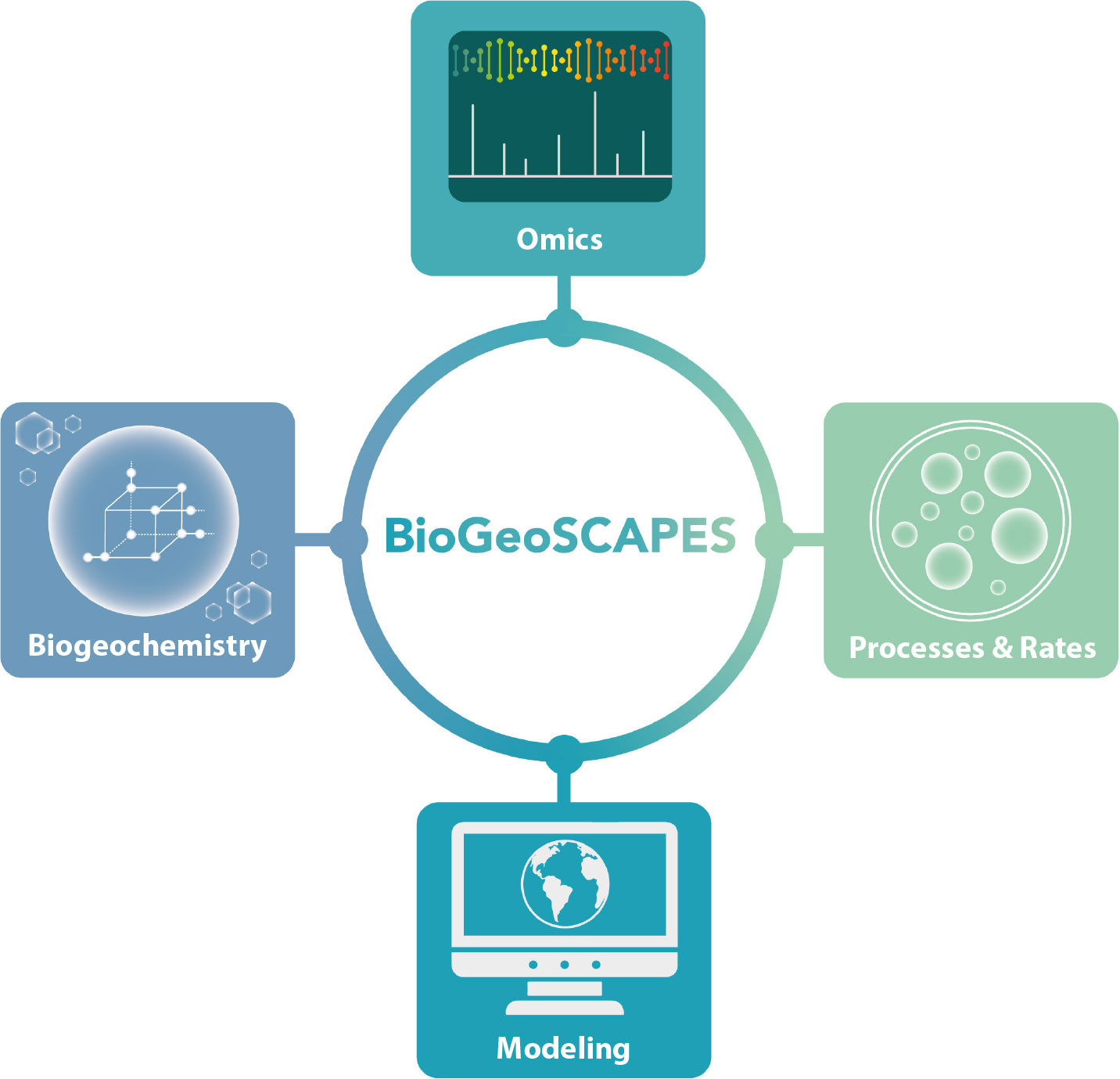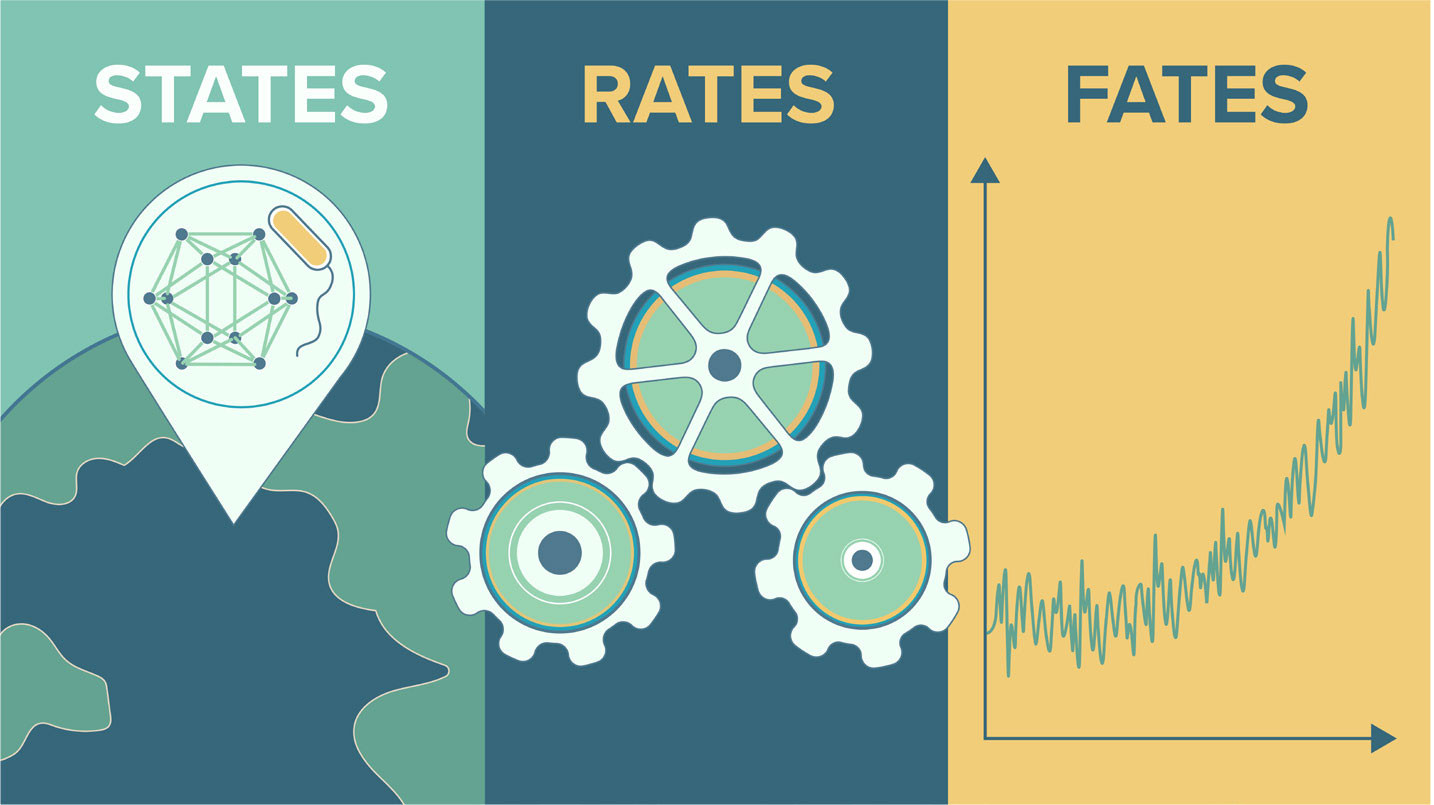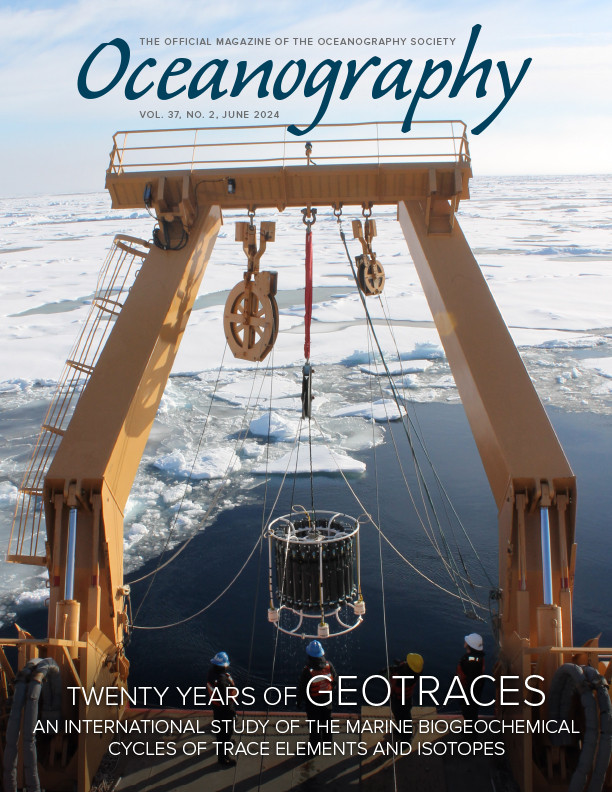Introduction
Earth’s life support system depends upon the planet’s biogeochemical cycles, phenomena that distinguish our planet from others in this solar system. Microorganisms (bacteria, archaea, fungi, and protists) are the primary drivers of these cycles. These single-celled organisms catalyze key biogeochemical reactions, and their activity underpins ecosystem services (Moran, 2015). Microbial processes make the atmosphere breathable, moderate the climate by regulating greenhouse gases, and recycle critical nutrients within aquatic and terrestrial ecosystems. Marine microbes, in particular, are responsible for approximately half of global photosynthesis (Field et al., 1998) as they cycle an organic carbon reservoir approximately the same size as the atmospheric carbon pool (Carlson and Hansell, 2015). Though critically important for maintaining Earth as a habitable environment and forming the base of marine food webs, much remains unknown about these microbes, including their biogeography, metabolic potential, chemical exchanges, and controls on their distribution. This is particularly true in the ocean, which is chronically undersampled due to the technical and logistical challenges of studying such a vast and dynamic environment. Despite over a century of discovering and characterizing Earth’s biogeochemistry, we still lack fundamental knowledge about the environmental and microbial controls on these essential cycles. This missing knowledge is necessary for our understanding of the Earth system and its sensitivity to perturbations across multiple temporal and spatial scales.
Understanding the controls on marine microbial dynamics and how microbes will respond to environmental change (IPCC, 2019; Kwiatkowski et al., 2020; Tagliabue et al., 2020) is essential for building and assessing model-based forecasts and generating robust projections of climate change impacts on ocean productivity and biogeochemical cycles (e.g., Intergovernmental Panel on Climate Change and Intergovernmental Science-Policy Platform on Biodiversity and Ecosystem Services assessments; Tagliabue, 2023). As a result of multiple concurrent human- and climate-driven impacts on the ocean environment (e.g., eutrophication, ocean acidification, warming, deoxygenation, loss of sea ice environments, ecosystem shifts, and pollution), the ocean habitats that exist now may change considerably in the next 10–15 years (Doney et al., 2009; Rabalais et al., 2009; Dutkiewicz et al., 2013; Sharma, 2015; Stramma and Schmidtko, 2019; Lannuzel et al., 2020). Predicting these shifts is essential for effective policy decisions and management approaches (IPCC, 2022).
There is, therefore, urgency to implement a global ocean microbial biogeochemistry program to elucidate interactions between microbes and their biogeochemical environments. Marine microbial communities and biogeochemical cycling have historically been studied by different research communities using distinct tools and data streams, and over different spatial and temporal scales, which together have impeded our ability to synthesize knowledge across disciplines. Integrating the study of microbial communities (i.e., their diversity, functions, and metabolisms), their elemental cycling, and numerical modeling across different spatial and temporal scales will provide the advances in fundamental understanding required to forecast future changes in the ocean’s metabolism, considered here as biogeochemical processes that occur in marine environments, on scales from within individual organisms and populations to those among communities and ecosystems.
An international community effort has been underway to create an ambitious global-scale marine microbial biogeochemistry research program to tackle the knowledge gaps in this field. The BioGeoSCAPES: Ocean Metabolism and Nutrient Cycles on a Changing Planet program will identify and quantify how marine microbes adjust to a changing climate and assess the consequences for global biogeochemical cycles. The vastness of the ocean environment requires the cooperation and collaboration of many nations to undertake a global-scale microbial biogeochemistry study. To accomplish this, BioGeoSCAPES will bring together scientists from nations around the world to combine various biological (including data-rich nucleic acid and biochemical omics), chemical (nutrients, micronutrients, organic compounds), and physical-parameter sampling along with modeling and experimental work. Recent advances in (bio)analytical and bioinformatics capabilities, combined with community-based momentum to organize intercalibration and standardization activities and emerging modeling tools, make this the ideal time for such a program.
The Science Vision of BioGeoSCAPES
The vision for BioGeoSCAPES is to understand how the ocean ensemble of microbial biochemical reactions and processes shape biogeochemical cycles and respond to and influence global change. The program will consist of interwoven ocean basin-scale sections and process studies, coastal and time-series studies, laboratory experiments, and modeling. Prior global-scale programs such as the World Ocean Circulation Experiment (WOCE; Schlitzer, 2000) and the ongoing GEOTRACES (Anderson, 2020) developed the capability for nutrient, biogeochemistry, and trace metal sample acquisition and data management on a full-depth, basin-scale level. Similarly, large-scale nucleic acid sequencing (metagenomic and meta-transcriptomic) sampling efforts, primarily conducted in the upper water column, have demonstrated the immense power of “big data” in understanding microbial communities and their functional activities (e.g., Global Ocean Sampling Expedition, Tara Oceans, and Malaspina). However, marine microbial biogeochemistry studies have literally skimmed the surface of the complexity of ocean ecosystems (Santoro, 2019).
Throughout the ocean, multiple concurrent drivers raise challenges for capturing the impacts of multifaceted interactions. There is an urgent need to assess the states of key ocean metabolisms by quantifying their distributions and drivers. Coastal and oceanic regions are profoundly affected by eutrophication and hypoxia, ocean acidification, deoxygenation, increased temperatures, changes in primary productivity, input of pollutants, and overharvesting of fisheries, to name some well-known anthropogenic impacts (Doney, 2010; Bopp et al., 2013). While GEOTRACES has greatly expanded knowledge about trace elements and isotopes in the mesopelagic and abyssal oceans, these depths remain largely understudied and overlooked with regard to many other biological and chemical parameters and are predicted to undergo some of the largest proportional changes in oxygen content, temperature, and pH by the end of the century (Schmidtko et al., 2017; Kwiatkowski et al., 2020). Integrating interdisciplinary observations, temporal/repeat sampling of specific regions, targeted laboratory experiments, and modeling will allow us to generate a new understanding of biogeochemical cycling in the ocean and the mechanisms that connect their variability to microbial processes.
Despite the success of earlier programs, connecting microbial organismal distributions and functions with biogeochemical processes is difficult (Strzepek et al., 2022). Research expeditions rarely measure together omics, processes, and environmental parameters (e.g., micronutrients, dissolved organic carbon, metabolites; Marchetti, 2019), and we often lack the ability to convert these measurements to the “currencies” used in models. Furthermore, few meta-omics datasets are collected and processed in the quantitative manner necessary to fully combine them with biogeochemical analyses and allow integration with global biogeochemical models. The BioGeoSCAPES program will address these scientific challenges and assess the fate of key ocean metabolisms in response to and interacting with ongoing environmental change. Specifically, the BioGeoSCAPES program will connect microbial processes and biogeochemical cycles by combining the capabilities of new omics and biogeochemistry (e.g., micronutrient and organic geochemistry) techniques, integrating computational biology and ocean biogeochemical modeling using numerical pipelines, and linking to process and rate studies (Figure 1). BioGeoSCAPES will build on lessons learned from GEOTRACES, such as integrating modeling at the onset and facilitating training and practice expeditions to work through logistical constraints. Also inspired by GEOTRACES, the program will be underpinned by robust standardization and intercalibration efforts to deliver interoperable datasets and data systems to which all nations can contribute. BioGeoSCAPES will enable discoveries of the fundamental controls on the ocean’s microbial biogeochemical system, and the rich datasets and new knowledge will provide a record of ocean metabolism to be studied for decades to come.

FIGURE 1. Four facets of science will contribute to the BioGeoSCAPES effort: omics approaches, biogeochemistry, processes and rates, and modeling. These interdisciplinary connections will foster new discoveries in the ocean sciences. > High res figure
|
BioGeoSCAPES will create the first global-scale sectional maps of key ocean metabolisms and their underlying drivers, revealing their linkages and feedback on ocean biogeochemical cycles. From these, BioGeoSCAPES promises to enable a new generation of ocean ecosystem modeling that integrates new omics data and understanding to transform our ability to deliver risk and vulnerability assessments regarding the fate of key ocean metabolisms important to society (Levine and Leles, 2021; Tagliabue, 2023). These goals are highly compatible with many of the UN Ocean Decade Challenges, including examining the effects of multiple stresses on the ocean, protecting marine ecosystems and fisheries, understanding interactions of ocean and climate, and enhancing a global ocean observing system for monitoring ecosystem health.
BioGeoSCAPES Organizing Efforts to Date
Community participation in BioGeoSCAPES has grown steadily through international workshops, including two in Woods Hole, Massachusetts (USA), in 2018 and 2023 and one in 2022 in London (UK). The first international workshop in 2018 developed an underlying scientific rationale, exploring a framework for an international program to assess global controls on ocean metabolism and nutrient cycling through coordinated, intercalibrated omics and chemical measurements. The “BioGeoSCAPES” name was chosen to represent this effort, building on the Seascapes concept (Kavanaugh et al., 2016), with the subhead “Ocean metabolism and nutrient cycles on a changing planet.” Ocean metabolism is a useful organizational concept as it operates at an intracellular scale for individual organisms, which then collectively interact to shape net metabolism at the assemblage level across ocean biomes. A workshop report was distributed through the BioGeoSCAPES website and social media (Maldonado et al., 2018). Broad scientific aims were developed and critical gaps in the current understanding of ocean metabolism were identified that could be filled by such a program. International community interest has been robust, with establishment of a network of 30 national ambassadors, thousands of engagements across BioGeoSCAPES communication platforms, and multiple BioGeoSCAPES sessions at Ocean Sciences Meetings. It was recognized that standardization and intercalibration efforts in the omics communities lagged behind those of the geochemistry community. As a result, two complementary intercalibration efforts supported by the US Ocean Carbon & Biogeochemistry Project Office (NSF OCE1850983 and NASA 80NSSC21K0413) were launched shortly thereafter: an Ocean Metaproteomic Intercomparison and an Ocean Nucleic Acids ‘Omics Working Group (Berube et al., 2022; Saito et al., preprint).
In 2022, an Accelerating Research through International Network-to-Network Collaborations (AccelNet) grant from the US National Science Foundation facilitated a leap forward in the pace of BioGeoSCAPES program development, enabling international meetings, support staff, and educational exchanges including a Fellows program launched in fall 2023. The next efforts involve workshops, webinars, and working groups focused on (1) a detailed, globally supported science plan, (2) identification of key scientific interests and goals via international thematic meetings, (3) intercalibration and standardized best practices, (4) data integration and management plans for cohesive interoperable global data products, (5) integration of modeling efforts across a range of scales, and (6) logistical and infrastructure needs. A key part of the BioGeoSCAPES mission rests on the ability to convert between omics measurements and rates of elemental flux (e.g., primary production, nitrogen cycle reactions) to enable integration of observations and models (Strzepek et al., 2019; Saito et al., 2020). This issue will be addressed by the SCOR working group (#170) PRIMO: Physiology and Rates in Microbial Oceanography aimed at developing a community and framework for co-designing new physiological metrics as currency converters to link omics datasets and biogeochemical models. This working group will work toward development of a core suite of marine microbial physiological measurements that are harmonized, low-cost, easy to use, and high throughput to promote co-measurement of omics, rates, and chemical parameters, and their ultimate integration and representation in biogeochemical and Earth system models.
In November 2023, the first international BioGeoSCAPES Science Plan workshop took place in Woods Hole with ~80 in-person and over 80 online participants from 19 nations. Beforehand, 17 nations submitted national meeting reports, and one Pan-European and one international workshop (April and September 2022) were held. Building on these inputs, three BioGeoSCAPES scientific research themes were identified at the science plan workshop (Figure 2), along with their respective deliverables:
1. States: mapping key ocean metabolisms over space and time to generate maps of the abundances of key microbes and microbial biogeochemical processes and their drivers, with repeat surveys in selected regions and coastal areas, as well as time series, to provide data on how states respond to natural and anthropogenic influences.
2. Rates: mechanisms connecting microbial metabolisms to nutrients and other biogeochemical cycles to build a conceptual framework for the links between microbial ecology and biogeochemical cycles.
3. Fates: predicting interactions with environmental factors to provide risk and vulnerability assessments for key ocean metabolisms on a changing planet.

FIGURE 2. A schematic from the recent 2023 Science Planning Workshop held in Woods Hole, Massachusetts, USA. The States, Rates, and Fates themes will correspond to major sections of the Science Plan outline. > High res figure
|
Workshop participants also discussed a variety of implementation strategies, and several volunteered to help organize future AccelNet efforts related to (1) writing a BioGeoSCAPES Science Plan, (2) modeling and data integration, (3) standardization and intercalibration, (4) informatics and data management, and (5) education and capacity building. The science plan and AccelNet activities will provide the necessary scientific and infrastructural framework to guide a collaborative international network of ocean metabolism researchers. High-level science themes and recommendations for field operations (e.g., section cruises, process studies, time series), laboratory experiments, modeling studies, bioinformatics workflows, and other activities will provide a wide range of opportunities for engagement. Development of standardized, community-vetted guidelines and protocols (e.g., sampling, analytical methods, QA/QC) with an eye toward capacity building will improve data comparability and create a more equitable playing field. We envision implementing an international program of this magnitude and complexity via a “franchise model” in which researchers and nations can leverage their strengths and available funding streams to build BioGeoSCAPES into their research programs. Centralized coordination and community building will provide vital connective tissue to sustain a vibrant research network.
Thanks to the continued efforts of scientists from many nations, BioGeoSCAPES program development is well underway, with the goal of launching by the mid-2020s. While work remains to complete the science plan, build infrastructure and data management capabilities, inspire the next generation of leaders, and expand an already thriving scientific network across nations and disciplines, the continued strong community engagement clearly demonstrates a commitment to the scientific goals. The interdisciplinary investigation of how the states, rates, and fates of a diverse range of ocean biomes operate will catalyze new discoveries and reveal the mechanistic underpinnings of Earth’s life support system. Together these advances will help our species understand and predict how the ocean’s “biogeoscapes,” and their intertwined microbial and elemental cycles, are changing.
Acknowledgments
We thank the many contributors to BioGeoSCAPES program development thus far, in particular, the participants in the recent 2023 Science Planning Meeting workshop. This work was supported by NSF AccelNet grant 2201571. We thank Leslie Auerbach for editorial support and Ichiko Sugiyama, Natalie Reiner, and Charin Park for graphic design support. The international GEOTRACES program is possible in part thanks to the support from the US National Science Foundation (Grant OCE-2140395) to the Scientific Committee on Oceanic Research (SCOR).



